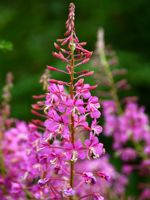Mon-Fri 9am - 5pm Mountain time
Fireweed vs Anise Hyssop
Chamaenerion angustifolium (Epilobium angustifolium)
Agastache foeniculum
CUSTOM GROW
NOT AVAILABLE THIS SEASON - MIGHT RETURN
Fireweed is a native perennial wildflower known for its tall spikes of bright pink to purple blooms. Its long-lasting summer flowers are an important nectar source for pollinators such as bees, butterflies, and hummingbirds, while its seeds provide food for birds. Its showy, long-lasting display makes it visually striking in naturalized plantings.
Fireweed gets its namesake because it is often one of the first species to return after wildfires, supporting ecosystem recovery. Its wind-dispersed seeds allow it to spread readily, making it highly effective in large-scale restoration, revegetation, and naturalization projects.
Fireweed is the Provincial Flower of the Yukon.
Anise Hyssop is a native perennial wildflower known for its fragrant spikes of small purple flowers. This plant is an excellent source of nectar and is highly attractive to a variety of bees and other pollinators. Deadheading spent flowers will encourage more blooms throughout the season.
Its aromatic leaves release an anise-like (licorice) scent when crushed. Both the leaves and seeds are edible and have been used in teas and as flavouring. Leaves can be harvested at any time, though the oil content is highest just past full bloom. Deer tend to avoid Anise Hyssop because of its strong-smelling leaves. This makes it a useful plant for positioning as a protective border around more vulnerable species.
Anise Hyssop spreads by seeds and rhizomes, but is less aggressive than other members of the mint family and is easy to remove if needed. Historically, it was planted in large numbers as a honey plant to support apiaries. Birds also feed on its seeds, adding to its ecological value.

